Jason Schneider
the Camera Collector
The Postwar Period: Ingenious Cameras Made in East Germany (DDR)
This is by no means the complete story of Dresden’s significance as a camera and lens manufacturing hub—that would require at least a
large format, illustrated volume, or perhaps a series of separate books devoted to the city’s early, prewar, and postwar manufacturing periods. However, to give you a visceral sense of the history of Dresden-made cameras, herewith a selection of early, prewar, and postwar models:
10 Great Cameras Made in East Germany (the DDR)
(Heartfelt thanks to Kosmo Foto, the source of much of the information contained in the following section.)
While the Deutsche Demokratische Republik was neither democratic nor a republic and its captive Germans lived under the thumb of the USSR, its mostly Dresden-based factories managed to turn out some mighty interesting and worthwhile cameras. Though often deprived of first-class finishing materials and hamstrung by inefficient communist factory organization they nevertheless turned out some ingenious cameras, many of which were reasonably successful on an increasingly competitive world market dominated by the Japanese. Here are some excellent postwar examples:
The Exakta VX (aka Varex) of 1951: Closely based on the trapezoidal-bodied Exakta I of 1936, the VX added an interchangeable finder (waist level or pentaprism), interchangeable viewing screens, two pin-type sockets for M and X flash sync, and a hinged back. It retained such charmingly idiosyncratic features as a hand-wound separate slow speed dial (down to 12 sec!) that required you to set the fast speed dial to B first, a built-in film cutting knife, a front mounted shutter release that enabled the use of externally coupled auto diaphragm lenses, and what may be the world’s longest throw, single stroke, left-handed film wind lever (would you believe 270 degrees?) Lake all classic Exaktas the VX, with its multifarious knobs and dials, has the look of precision German machinery and it sold quite well. Hardly the last word in convenience it exudes gobs of character and can take excellent pictures when fitted with a good period lens such as a 50mm f/2.8 Zeiss Jena Tessar or a 58mm f/2 Zeiss Biotar. You can snag a clean functional VX with lens and pentaprism for around 100 bucks, sometimes even less.
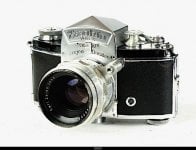
Exakta VX of 1951: Based on the Exakta I of 1936, its interchangeable prism finder and screens, flash sync, and hinged back were major upgrades.
Praktina FX 1953. Announced by KW (Kamera-Werkstatten) of Dresden, as an upgraded version of the original Praktina of 1952, the FX , designed by Siegfried Bohm, was conceived as a 35mm SLR system aimed at professionals, a counterpart to the broad spectrum M-42 screw mount Praktflex introduced in 1939. It features a unique breech-lock lens mount, an interchangeable pentaprism with interchangeable viewing screens, and a removable back. This allowed a 400-exposure, bulk film magazines to be fitted, and the camera also provided couplings for an ingenious 20-frame-per-wind spring motor drive, and (later) an electric motor drive with remote control, the first on any production 35mm SLR. The elegantly proportioned, nicely finished FX was compatible with a host of lenses by Zeiss, Meyer, Schacht, Steinheil et al, and scads of system accessories. It stops the lens down to the pre-selected aperture, and like all Praktinas, it features a built in Newtonian optical finder for 50mm lenses. While technically advanced, physically attractive, and well finished, Praktinas are not paragons of reliability, and their ingenious but non-standard lens mount, limited their sales potential. However, its design assuredly influenced such successful successors as the Nikon F. Today all Praktinas are coveted as collector’s items and fetch prices in the $150-$350 range.
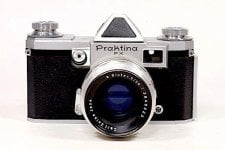
Praktina FX with 58mm F/2 Zeiss Biotar: An elegant, well made full system SLR with advanced features, it was beset with reliability problems and didn't sell.
Penti (1958) While luxury items were officially condemned as decadent by the East German communists, they didn’t mind flogging a few glitzy baubles to garner some hard currency from the filthy capitalists. That’s one explanation for the adorably fashionable half-framePenti that made 24 18x24mm exposures on 35mm film in Agfa Rapid style cartridges and had no rewind knob. Designed by Walter Hennig at VEB Zeiss Ikon it was originally released in the late 1950s as the Welta Orix, and in the 1960s production was moved to VEB Zeiss Ikon. The metallic gold finished (or rare grey finished) Penti was available with a red, white, black, or blue main body section, and it resembles a clutch purse more than a camera—just the thing for taking shots along the streets of the Riviera or San Tropez. Most were fitted with a 30mm f/3.5 Meyer Trioplan lens that focuses down to 1 meter and stops down to f/22, had 1/30-1/125 plus B leaf shutters with, and built-in flash sync. You can snag an original Penti or the later Penti II with Meyer Domiplan lens for around $50-$100, but you’d better get it with a few extra cartridges if you plan to reload them and shoot with it.
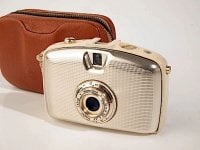
Penti half frame 35 with 30mm f/3.5 Meyer Trioplan lens: This gold and cream colored cutie proves the East Germans could cater to decadent capitalists.
Praktica IV F (1963-1966): Affectionately known as the Hunchback of Praktica, it was last camera to be produced by Kamera-Werkstatten (KW) before it merged with Pentacon. The original Praktica IV launched in 1959 featured a distinctive humped pentaprism instead of the waist level finder on the Praktica FX and some Art Deco fans found it appealing. It also had some curious quirks, including a double disc rewind knob that works as a fold-out lever for rewinding, and shutter speeds of ½ to 1/500 sec set on a twin (fast and slow speed), top mounted shutter speed dial that rotates when cocking the shutter. Other features: M-42 threaded lens mount, noninterchangeable Fresnel matte screen with central split-image rangefinder surrounded by a ground glass collar, bottom-mounted rapid winder supplemented by a top-mounted film wind knob, coaxial X- and F-sync sockets, and a non-instant return mirror. According to Camerapedia, 20,445 units were made over its 3-year production run and it paved the way for 3 decades of broad-spectrum M-42 mount 35mm SLRs bearing the Praktica name. Used price range with lens: $70-140.
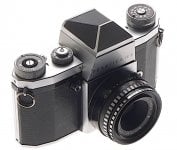
Praktica IV F with mediocre 50mm f/2.8 Meyer Domiplan lens: Cumbersome klutz or art deco masterpiece, it paved the way for future M-42 mount Prakticas.
Werra (1959): The apotheosis of elegant minimalism, the Werra, named after a small German river, was manufactured by the Carl Zeiss Jena plant in Dresden which was primarily a lens making facility. Somewhat chunky, it is nevertheless a 35mm design classic with a bare top plate devoid of anything but a shutter release. To cock the 1-1/500 sec plus B Prestor shutter, simply twist the ring behind the lens; the conical lens cover also reverses (after removing the circular front section) to become a lens hood. The controls you’d expect to see on the top plate (such as the rewind crank) are on the bottom. The lens is usually a 50mm f/2.8 Zeiss Tessar (sometimes labeled Jena T to avoid copyright disputes) and there’s a Pentacon tower logo on the lower left-hand side if the barrel that’s derived from the famed Ernemann tower built in Dresden in 1924, that was used as the original Ernemann logo. During the ‘60s CZ Jena produced several different Werra models, all featuring film wind/shutter cocking rings behind the lens and based on the same design esthetic. There was a coveted olive green-covered version of the basic Werra 1, a Werra 2 and Werramatic models with built-in selenium meters, and Werra III, IV, and V models (including the Werramatic) that had built-in coupled rangefinders and interchangeable bayonet mount 35mm wide-angle and 100mm telephoto lenses that mount in front of the leaf shutter. In their own understated way, all Werras are great user-collectibles, and they’re affordable, ranging from about $100=$275 in clean working condition depending on the model.
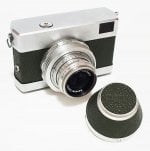
Werra I with 50mm f/2.8 Carl Zeiss Jena Tessar lens and signature lens cover that doubled as a lens hood. It sired a series of more complex offspring.
Pentina (1961-1965): The relatively rare Pentina is an advanced leaf shutter 24 x 36mm format interchangeable lens 35mm SLR made by VEB Kamere-und-Kinowerke, Dresden (renamed VEB Pentacon in 1964). Featuring a large, clean, neo-Bauhaus form factor, it was introduced at a time when Soviet and East German camera makers were striving to compete with their West German rivals that were then offering sophisticated state-of the-art leaf shutter SLRs like the Zeiss Contaflex, Kodak Retina Reflex, and the Voigtlander Bessamatic. Cameras of this type are inherently much more complex to build than the focal plane shutter SLRs the company had been making for years, and the Dresden-based camera maker clearly wanted to prove its engineering and manufacturing prowess. At first glance the Pentina doesn’t even look like an SLR since the telltale pentaprism is hidden behind a chrome finished aluminum frame. Lacking access to West German Compur and Prontor leaf shutters, Pentacon had to develop their own, and the 1-1/500 sec plus B Prestor-00 leaf shutter used in the Pentina represented the apex of these efforts. Unfortunately, due to its incredible complexity, the camera became far too expensive to sell in large numbers in East Germany or to compete successfully in the high-priced class in the West. As a result, only 45,000 units were produced, and production ceased in 1965.
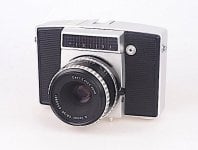
Pentina with 50mm f/2.8 Carl Zeiss Jena Tessar lens: VEB Pentacon's leaf shutter 35mm SLR was audacious but overly complex and too expensive to sell.
The Pentina’s bayonet mount interchangeable lenses include a 50mm f/2.8 Zeiss Jena Tessar furnished as standard with every camera, a 30mm f/3.5 Meyer Lydith, an 85mm f/2.8 Carl Zeiss Jena Cardinar, and a 135mm f/4 Meyer Domigor. It also had a built-in match needle selenium metering system with film speed settings from ASA 6-1600, a quick release lever (but no instant-return mirror), full MX sync, self-timer, and a bottom mounted rewind crank and film type reminder. In addition to the basic model described, the Pentina M added a screen with a central split image rangefinder, the Pentina fm has a screen with a central split-image plus microprism collar, and the Pentina E was a simplified meter-less model. Though uncommon, the Pentina (any model) in working condition with 50mm f/2.8 Tessar is typically an affordable collectible, fetching about $100-$200.
Pentacon Six (1966) The camera makers of Dresden were certainly no strangers to designing workable 6 x 6 cm SLRs, and the Reflex-Korelle by Franz Kochman (later Korellewerke KG) and the spartan Pilot 6 by KW are excellent prewar examples. Indeed, the Pentacon 6, a redesigned and improved version of the troublesome Praktisix made by the Kamera Werkstatten division of the VEB Pentacon empire, was conceptually based on the Korelle, which also influenced the West German Exakta 66, the Japanese Norita 66, and the Ukrainian Kiev 60. Supported by a complete line of superb Carl Zeiss Jena lenses ranging from 50mm to 1000mm, the Pentacon Six has a much brighter viewfinder than its predecessor and its revised film transport system mitigated the problem of overlapping frames. Its waist-level and prism finders were augmented by a TTL metering prism (models designed for the meter prism were dubbed Pentacon Six TL), making it a more attractive proposition. However, it was dogged by reliability and frame-spacing problems for all its successive iterations and never achieved widespread acceptance by professional photographers in the West despite its fine optical performance.
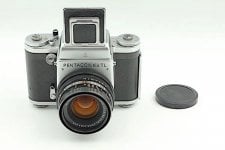
Pentacon Six TL with 80mm f/2.8 Carl Zeiss Biometar lens: Shown with waist-level finder, it could be fitted with a TTL meter prism, system accessories.
The Pentacon Six employs a horizontal cloth focal-plane shutter with speeds of 1-1/1000 sec plus B, provides M sync, X sync at 1/30, and uses the long lived Praktisix breech lock bayonet mount. Standard lens is the 80mm f/2.8 Carl Zeiss Jena MC Biometar, an excellent 5-element, 4- group design. Used price in clean working condition with 80mm f/2.8 lens: $300-$450. The price is right, and some people do love ‘em, but it’s a risky proposition, and repairs are hard to come by.
Pentacon Super (1966): The “Commie’s answer to the Nikon F”, this remarkable machine was Pentacon’s final attempt to go up against the increasingly sophisticated 35mm SLRs coming out of Japan, and to offer a reliable system SLR successor to the ill-fated Praktinas that would entice professional and advanced shooters. Announced at the ’66 Leipzig Fair, it features a very quiet, reliable hybrid metal/rubberized cloth vertical focal plane shutter with speeds of 1-1/2000 sec plus B, an interchangeable meter prism with its own battery, interchangeable viewing screens, and an extensive range of system accessories including a 56-foot bulk film magazine aimed at reporters. It used a special range of M-42 screw mount lenses that provided open aperture metering using an electronic aperture simulation system and provides stop-down TTL metering with standard M-42 mount lenses. Most Pentacon Supers were shipped with the acclaimed 55mm f/1.4 Zeiss Jena Pancolar, claimed to exceed the performance if comparable Nikon and Canon lenses. Regrettably, this superb camera, which may well be the finest Dresden-made 35mm SLR ever, was released shortly after the introduction of the mediocre low-end Praktica Nova range that tarnished the company’s reputation. It was also extremely expensive to produce, higher priced than its well-established competitors, and sadly phased out after a short production run of fewer than 5000 cameras. Today the Pentacon Super is a rare and prized collectible that fetches about $2,500-$3,500 with standard 55mm f/1.4 lens—if you’re lucky enough to find one.
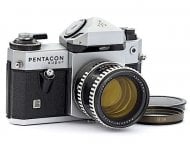
Pentacon Super: A professional full system 35mm SLR to rival the Nikon F it was the most advanced Pentacon ever, but too expensive to be competitive.
Praktica L (1969): Prakticas were quite popular on both sides of the Iron Curtain, but VEB Pentacon decided to proactively inaugurate a new family of Praktica 35mm SLRs anyway, all sporting metal, vertical travel focal-plane shutters conceptually similar to the well-known Copal Square from Japan. The first of these was the Praktica L and the last was the Praktica MTL 50. Sporting the same classic M-42 lens mount as its predecessors, the L series embodied the classic Praktica look— a chrome or black finished body, covered by a wide swath of leather textured material, a classic angled front mounted right hand shutter release and a discreetly contoured pentaprism housing, It paved the way for a series of future Prakticas, including the EE and MTL. Its shutter has speeds of 1-1/1000 sec plus B in the odd non-geometric sequence of B, 1, ½, 1/5/ 1/10, 1/25, 150, 1/100, 1/200, 1/500, and 1/1000 sec, with X-sync at 1/125 sec. Its fixed eyelevel pentaprism finder has a Fresnel lens and central microprism, and it incorporates an easy loading system and an instant-return mirror. There are versions with a large shutter release and with and without the Pentacon tower logo on the pentaprism housing. Standard lens was the mediocre 50mm f/2.8 Meyer Domiplan, but many were sold with excellent quality Carl Zeiss Jena (or CZ Jena) lenses such as the 50mm f/1.8 Zeiss Pancolar. It’s not a collector’s heartthrob but the Praktica L is a reliable, competent shooter and a bargain at $50-$100 with lens.
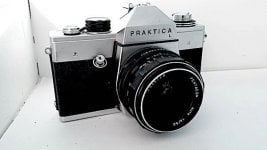
Praktica L with 50mm f/1.8 Pentacon auto lens: A competent 35mm SLR with a vertical metal focal plane shutter and fixed, it's affordable and a good shooter.
Praktica VLC, VLC2, and VLC3 (1975): First released in 1975 these handsome TTL-metering 35mm SLRs are closely based on the last gasp Exakta RTL 1000 except that the Praktica VLC, like the LLC, has flat electrical contacts outboard of the lens mount for transferring aperture information from dedicated electric M-42 lenses to the camera body, allowing full-aperture, center-weighted, match-needle metering. Viewfinders and screens are also interchangeable and there was a waist-level finder and another with a high magnification for macro work. The standard screen has central microprism with surrounding clear glass collar. The plain VLC was built in much larger quantities than the VLC 2 (which has a more ergonomic plastic tipped rewind crank) or the VLC 3 (which has a quieter shutter and meter mode indications in the finder). The vertical metal bladed focal plane shutter provides speeds of 1-1/1000 sec plus B with X sync at 1/125 sec. Other features: mechanical self-timer, and an easy loading system with film leader clip. The VLC (any model) is not quite a system camera, but it’s adaptable, well made, reliable, and (when fitted with pone of the lenses below) a great shooter. Used price in clean condition with 50mm f/1.8 Pentacon electric or (contactless) 50mm f/1.8 Pancolar lens for stop-down readings, $125-$175.
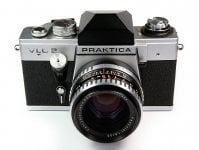
Praktica VLC 2 with excellent 50mm f/1.8 Pancolar lens: It's an Exata RTL 1000 with Praktica LLC style electronic full aperture metering with special M-42 mount lenses.
This is by no means the complete story of Dresden’s significance as a camera and lens manufacturing hub—that would require at least a
large format, illustrated volume, or perhaps a series of separate books devoted to the city’s early, prewar, and postwar manufacturing periods. However, to give you a visceral sense of the history of Dresden-made cameras, herewith a selection of early, prewar, and postwar models:
10 Great Cameras Made in East Germany (the DDR)
(Heartfelt thanks to Kosmo Foto, the source of much of the information contained in the following section.)
While the Deutsche Demokratische Republik was neither democratic nor a republic and its captive Germans lived under the thumb of the USSR, its mostly Dresden-based factories managed to turn out some mighty interesting and worthwhile cameras. Though often deprived of first-class finishing materials and hamstrung by inefficient communist factory organization they nevertheless turned out some ingenious cameras, many of which were reasonably successful on an increasingly competitive world market dominated by the Japanese. Here are some excellent postwar examples:
The Exakta VX (aka Varex) of 1951: Closely based on the trapezoidal-bodied Exakta I of 1936, the VX added an interchangeable finder (waist level or pentaprism), interchangeable viewing screens, two pin-type sockets for M and X flash sync, and a hinged back. It retained such charmingly idiosyncratic features as a hand-wound separate slow speed dial (down to 12 sec!) that required you to set the fast speed dial to B first, a built-in film cutting knife, a front mounted shutter release that enabled the use of externally coupled auto diaphragm lenses, and what may be the world’s longest throw, single stroke, left-handed film wind lever (would you believe 270 degrees?) Lake all classic Exaktas the VX, with its multifarious knobs and dials, has the look of precision German machinery and it sold quite well. Hardly the last word in convenience it exudes gobs of character and can take excellent pictures when fitted with a good period lens such as a 50mm f/2.8 Zeiss Jena Tessar or a 58mm f/2 Zeiss Biotar. You can snag a clean functional VX with lens and pentaprism for around 100 bucks, sometimes even less.

Exakta VX of 1951: Based on the Exakta I of 1936, its interchangeable prism finder and screens, flash sync, and hinged back were major upgrades.
Praktina FX 1953. Announced by KW (Kamera-Werkstatten) of Dresden, as an upgraded version of the original Praktina of 1952, the FX , designed by Siegfried Bohm, was conceived as a 35mm SLR system aimed at professionals, a counterpart to the broad spectrum M-42 screw mount Praktflex introduced in 1939. It features a unique breech-lock lens mount, an interchangeable pentaprism with interchangeable viewing screens, and a removable back. This allowed a 400-exposure, bulk film magazines to be fitted, and the camera also provided couplings for an ingenious 20-frame-per-wind spring motor drive, and (later) an electric motor drive with remote control, the first on any production 35mm SLR. The elegantly proportioned, nicely finished FX was compatible with a host of lenses by Zeiss, Meyer, Schacht, Steinheil et al, and scads of system accessories. It stops the lens down to the pre-selected aperture, and like all Praktinas, it features a built in Newtonian optical finder for 50mm lenses. While technically advanced, physically attractive, and well finished, Praktinas are not paragons of reliability, and their ingenious but non-standard lens mount, limited their sales potential. However, its design assuredly influenced such successful successors as the Nikon F. Today all Praktinas are coveted as collector’s items and fetch prices in the $150-$350 range.

Praktina FX with 58mm F/2 Zeiss Biotar: An elegant, well made full system SLR with advanced features, it was beset with reliability problems and didn't sell.
Penti (1958) While luxury items were officially condemned as decadent by the East German communists, they didn’t mind flogging a few glitzy baubles to garner some hard currency from the filthy capitalists. That’s one explanation for the adorably fashionable half-framePenti that made 24 18x24mm exposures on 35mm film in Agfa Rapid style cartridges and had no rewind knob. Designed by Walter Hennig at VEB Zeiss Ikon it was originally released in the late 1950s as the Welta Orix, and in the 1960s production was moved to VEB Zeiss Ikon. The metallic gold finished (or rare grey finished) Penti was available with a red, white, black, or blue main body section, and it resembles a clutch purse more than a camera—just the thing for taking shots along the streets of the Riviera or San Tropez. Most were fitted with a 30mm f/3.5 Meyer Trioplan lens that focuses down to 1 meter and stops down to f/22, had 1/30-1/125 plus B leaf shutters with, and built-in flash sync. You can snag an original Penti or the later Penti II with Meyer Domiplan lens for around $50-$100, but you’d better get it with a few extra cartridges if you plan to reload them and shoot with it.

Penti half frame 35 with 30mm f/3.5 Meyer Trioplan lens: This gold and cream colored cutie proves the East Germans could cater to decadent capitalists.
Praktica IV F (1963-1966): Affectionately known as the Hunchback of Praktica, it was last camera to be produced by Kamera-Werkstatten (KW) before it merged with Pentacon. The original Praktica IV launched in 1959 featured a distinctive humped pentaprism instead of the waist level finder on the Praktica FX and some Art Deco fans found it appealing. It also had some curious quirks, including a double disc rewind knob that works as a fold-out lever for rewinding, and shutter speeds of ½ to 1/500 sec set on a twin (fast and slow speed), top mounted shutter speed dial that rotates when cocking the shutter. Other features: M-42 threaded lens mount, noninterchangeable Fresnel matte screen with central split-image rangefinder surrounded by a ground glass collar, bottom-mounted rapid winder supplemented by a top-mounted film wind knob, coaxial X- and F-sync sockets, and a non-instant return mirror. According to Camerapedia, 20,445 units were made over its 3-year production run and it paved the way for 3 decades of broad-spectrum M-42 mount 35mm SLRs bearing the Praktica name. Used price range with lens: $70-140.

Praktica IV F with mediocre 50mm f/2.8 Meyer Domiplan lens: Cumbersome klutz or art deco masterpiece, it paved the way for future M-42 mount Prakticas.
Werra (1959): The apotheosis of elegant minimalism, the Werra, named after a small German river, was manufactured by the Carl Zeiss Jena plant in Dresden which was primarily a lens making facility. Somewhat chunky, it is nevertheless a 35mm design classic with a bare top plate devoid of anything but a shutter release. To cock the 1-1/500 sec plus B Prestor shutter, simply twist the ring behind the lens; the conical lens cover also reverses (after removing the circular front section) to become a lens hood. The controls you’d expect to see on the top plate (such as the rewind crank) are on the bottom. The lens is usually a 50mm f/2.8 Zeiss Tessar (sometimes labeled Jena T to avoid copyright disputes) and there’s a Pentacon tower logo on the lower left-hand side if the barrel that’s derived from the famed Ernemann tower built in Dresden in 1924, that was used as the original Ernemann logo. During the ‘60s CZ Jena produced several different Werra models, all featuring film wind/shutter cocking rings behind the lens and based on the same design esthetic. There was a coveted olive green-covered version of the basic Werra 1, a Werra 2 and Werramatic models with built-in selenium meters, and Werra III, IV, and V models (including the Werramatic) that had built-in coupled rangefinders and interchangeable bayonet mount 35mm wide-angle and 100mm telephoto lenses that mount in front of the leaf shutter. In their own understated way, all Werras are great user-collectibles, and they’re affordable, ranging from about $100=$275 in clean working condition depending on the model.

Werra I with 50mm f/2.8 Carl Zeiss Jena Tessar lens and signature lens cover that doubled as a lens hood. It sired a series of more complex offspring.
Pentina (1961-1965): The relatively rare Pentina is an advanced leaf shutter 24 x 36mm format interchangeable lens 35mm SLR made by VEB Kamere-und-Kinowerke, Dresden (renamed VEB Pentacon in 1964). Featuring a large, clean, neo-Bauhaus form factor, it was introduced at a time when Soviet and East German camera makers were striving to compete with their West German rivals that were then offering sophisticated state-of the-art leaf shutter SLRs like the Zeiss Contaflex, Kodak Retina Reflex, and the Voigtlander Bessamatic. Cameras of this type are inherently much more complex to build than the focal plane shutter SLRs the company had been making for years, and the Dresden-based camera maker clearly wanted to prove its engineering and manufacturing prowess. At first glance the Pentina doesn’t even look like an SLR since the telltale pentaprism is hidden behind a chrome finished aluminum frame. Lacking access to West German Compur and Prontor leaf shutters, Pentacon had to develop their own, and the 1-1/500 sec plus B Prestor-00 leaf shutter used in the Pentina represented the apex of these efforts. Unfortunately, due to its incredible complexity, the camera became far too expensive to sell in large numbers in East Germany or to compete successfully in the high-priced class in the West. As a result, only 45,000 units were produced, and production ceased in 1965.

Pentina with 50mm f/2.8 Carl Zeiss Jena Tessar lens: VEB Pentacon's leaf shutter 35mm SLR was audacious but overly complex and too expensive to sell.
The Pentina’s bayonet mount interchangeable lenses include a 50mm f/2.8 Zeiss Jena Tessar furnished as standard with every camera, a 30mm f/3.5 Meyer Lydith, an 85mm f/2.8 Carl Zeiss Jena Cardinar, and a 135mm f/4 Meyer Domigor. It also had a built-in match needle selenium metering system with film speed settings from ASA 6-1600, a quick release lever (but no instant-return mirror), full MX sync, self-timer, and a bottom mounted rewind crank and film type reminder. In addition to the basic model described, the Pentina M added a screen with a central split image rangefinder, the Pentina fm has a screen with a central split-image plus microprism collar, and the Pentina E was a simplified meter-less model. Though uncommon, the Pentina (any model) in working condition with 50mm f/2.8 Tessar is typically an affordable collectible, fetching about $100-$200.
Pentacon Six (1966) The camera makers of Dresden were certainly no strangers to designing workable 6 x 6 cm SLRs, and the Reflex-Korelle by Franz Kochman (later Korellewerke KG) and the spartan Pilot 6 by KW are excellent prewar examples. Indeed, the Pentacon 6, a redesigned and improved version of the troublesome Praktisix made by the Kamera Werkstatten division of the VEB Pentacon empire, was conceptually based on the Korelle, which also influenced the West German Exakta 66, the Japanese Norita 66, and the Ukrainian Kiev 60. Supported by a complete line of superb Carl Zeiss Jena lenses ranging from 50mm to 1000mm, the Pentacon Six has a much brighter viewfinder than its predecessor and its revised film transport system mitigated the problem of overlapping frames. Its waist-level and prism finders were augmented by a TTL metering prism (models designed for the meter prism were dubbed Pentacon Six TL), making it a more attractive proposition. However, it was dogged by reliability and frame-spacing problems for all its successive iterations and never achieved widespread acceptance by professional photographers in the West despite its fine optical performance.

Pentacon Six TL with 80mm f/2.8 Carl Zeiss Biometar lens: Shown with waist-level finder, it could be fitted with a TTL meter prism, system accessories.
The Pentacon Six employs a horizontal cloth focal-plane shutter with speeds of 1-1/1000 sec plus B, provides M sync, X sync at 1/30, and uses the long lived Praktisix breech lock bayonet mount. Standard lens is the 80mm f/2.8 Carl Zeiss Jena MC Biometar, an excellent 5-element, 4- group design. Used price in clean working condition with 80mm f/2.8 lens: $300-$450. The price is right, and some people do love ‘em, but it’s a risky proposition, and repairs are hard to come by.
Pentacon Super (1966): The “Commie’s answer to the Nikon F”, this remarkable machine was Pentacon’s final attempt to go up against the increasingly sophisticated 35mm SLRs coming out of Japan, and to offer a reliable system SLR successor to the ill-fated Praktinas that would entice professional and advanced shooters. Announced at the ’66 Leipzig Fair, it features a very quiet, reliable hybrid metal/rubberized cloth vertical focal plane shutter with speeds of 1-1/2000 sec plus B, an interchangeable meter prism with its own battery, interchangeable viewing screens, and an extensive range of system accessories including a 56-foot bulk film magazine aimed at reporters. It used a special range of M-42 screw mount lenses that provided open aperture metering using an electronic aperture simulation system and provides stop-down TTL metering with standard M-42 mount lenses. Most Pentacon Supers were shipped with the acclaimed 55mm f/1.4 Zeiss Jena Pancolar, claimed to exceed the performance if comparable Nikon and Canon lenses. Regrettably, this superb camera, which may well be the finest Dresden-made 35mm SLR ever, was released shortly after the introduction of the mediocre low-end Praktica Nova range that tarnished the company’s reputation. It was also extremely expensive to produce, higher priced than its well-established competitors, and sadly phased out after a short production run of fewer than 5000 cameras. Today the Pentacon Super is a rare and prized collectible that fetches about $2,500-$3,500 with standard 55mm f/1.4 lens—if you’re lucky enough to find one.

Pentacon Super: A professional full system 35mm SLR to rival the Nikon F it was the most advanced Pentacon ever, but too expensive to be competitive.
Praktica L (1969): Prakticas were quite popular on both sides of the Iron Curtain, but VEB Pentacon decided to proactively inaugurate a new family of Praktica 35mm SLRs anyway, all sporting metal, vertical travel focal-plane shutters conceptually similar to the well-known Copal Square from Japan. The first of these was the Praktica L and the last was the Praktica MTL 50. Sporting the same classic M-42 lens mount as its predecessors, the L series embodied the classic Praktica look— a chrome or black finished body, covered by a wide swath of leather textured material, a classic angled front mounted right hand shutter release and a discreetly contoured pentaprism housing, It paved the way for a series of future Prakticas, including the EE and MTL. Its shutter has speeds of 1-1/1000 sec plus B in the odd non-geometric sequence of B, 1, ½, 1/5/ 1/10, 1/25, 150, 1/100, 1/200, 1/500, and 1/1000 sec, with X-sync at 1/125 sec. Its fixed eyelevel pentaprism finder has a Fresnel lens and central microprism, and it incorporates an easy loading system and an instant-return mirror. There are versions with a large shutter release and with and without the Pentacon tower logo on the pentaprism housing. Standard lens was the mediocre 50mm f/2.8 Meyer Domiplan, but many were sold with excellent quality Carl Zeiss Jena (or CZ Jena) lenses such as the 50mm f/1.8 Zeiss Pancolar. It’s not a collector’s heartthrob but the Praktica L is a reliable, competent shooter and a bargain at $50-$100 with lens.

Praktica L with 50mm f/1.8 Pentacon auto lens: A competent 35mm SLR with a vertical metal focal plane shutter and fixed, it's affordable and a good shooter.
Praktica VLC, VLC2, and VLC3 (1975): First released in 1975 these handsome TTL-metering 35mm SLRs are closely based on the last gasp Exakta RTL 1000 except that the Praktica VLC, like the LLC, has flat electrical contacts outboard of the lens mount for transferring aperture information from dedicated electric M-42 lenses to the camera body, allowing full-aperture, center-weighted, match-needle metering. Viewfinders and screens are also interchangeable and there was a waist-level finder and another with a high magnification for macro work. The standard screen has central microprism with surrounding clear glass collar. The plain VLC was built in much larger quantities than the VLC 2 (which has a more ergonomic plastic tipped rewind crank) or the VLC 3 (which has a quieter shutter and meter mode indications in the finder). The vertical metal bladed focal plane shutter provides speeds of 1-1/1000 sec plus B with X sync at 1/125 sec. Other features: mechanical self-timer, and an easy loading system with film leader clip. The VLC (any model) is not quite a system camera, but it’s adaptable, well made, reliable, and (when fitted with pone of the lenses below) a great shooter. Used price in clean condition with 50mm f/1.8 Pentacon electric or (contactless) 50mm f/1.8 Pancolar lens for stop-down readings, $125-$175.

Praktica VLC 2 with excellent 50mm f/1.8 Pancolar lens: It's an Exata RTL 1000 with Praktica LLC style electronic full aperture metering with special M-42 mount lenses.
das
Well-known
A wonderful read and an excellent series, as usual!
Many post-war East German camera products are fantastic and many remained competitive through the early 1980s. Some of my favorites include:
1 .The MC 35mm Carl Zeiss Jena lenses from the 1970s-80s in M42 and PB mount.
2. The Praktica PB series of cameras and lenses.
3. The Pentacon Six TL and its CZJ lenses.
4. The 1950s Contax S SLR line.
It is sometimes weird to fall down the rabbit hole which was the Pentacon corporation. Some people have said that Pentacon actually invented the TTL flash and then sold/licensed the tech to Olympus. Never was a huge fan of the 1960-70s Praktica M42 cameras, although the EE3 was a somewhat interesting camera.
Many post-war East German camera products are fantastic and many remained competitive through the early 1980s. Some of my favorites include:
1 .The MC 35mm Carl Zeiss Jena lenses from the 1970s-80s in M42 and PB mount.
2. The Praktica PB series of cameras and lenses.
3. The Pentacon Six TL and its CZJ lenses.
4. The 1950s Contax S SLR line.
It is sometimes weird to fall down the rabbit hole which was the Pentacon corporation. Some people have said that Pentacon actually invented the TTL flash and then sold/licensed the tech to Olympus. Never was a huge fan of the 1960-70s Praktica M42 cameras, although the EE3 was a somewhat interesting camera.
Jason Schneider
the Camera Collector
A wonderful read and an excellent series, as usual!
Many post-war East German camera products are fantastic and many remained competitive through the early 1980s. Some of my favorites include:
1 .The MC 35mm Carl Zeiss Jena lenses from the 1970s-80s in M42 and PB mount.
2. The Praktica PB series of cameras and lenses.
3. The Pentacon Six TL and its CZJ lenses.
4. The 1950s Contax S SLR line.
It is sometimes weird to fall down the rabbit hole which was the Pentacon corporation. Some people have said that Pentacon actually invented the TTL flash and then sold/licensed the tech to Olympus. Never was a huge fan of the 1960-70s Praktica M42 cameras, although the EE3 was a somewhat interesting camera.
Thanks for your kind words. Carl Zeiss Jena lenses are optically outstanding and I like the Pentacon Six and the Contax S. The camera I'd really love to acquire is the Pentacon Super, but with current prices hovering over $2K with 55mm f/1.4 Pancolar that's not going to happen.
das
Well-known
Thanks for your kind words. Carl Zeiss Jena lenses are optically outstanding and I like the Pentacon Six and the Contax S. The camera I'd really love to acquire is the Pentacon Super, but with current prices hovering over $2K with 55mm f/1.4 Pancolar that's not going to happen.
Word on the street is that the first version of the PB 50mm f/1.4 is an updated version of the 55mm f/1.4 M42 Pancolar. The second version of the PB 1.4 is apparently better than both. I don't have either though.
Pál_K
Cameras. I has it.
A wonderful lesson in history and of Dresden’s photo industry - thank you.
To me, the Pentacon Six has an inexplicable siren-like appeal which has probably sent many a photographer onto the rocks. I think it’s the big focal plane shutter. I saw one recently for a good price plus a wide angle lens - I hesitated and did not buy it. But I still think about it.
To me, the Pentacon Six has an inexplicable siren-like appeal which has probably sent many a photographer onto the rocks. I think it’s the big focal plane shutter. I saw one recently for a good price plus a wide angle lens - I hesitated and did not buy it. But I still think about it.
Dralowid
Michael
I'm very much an amateur when it comes to working on cameras however I have, in the past, brought two Pentinas back to life. They are indeed odd cameras but I would not describe them as overly complex.
I think their reputation for complexity comes from them not being constructed like other cameras. When you get your hands on one you find yourself looking at it just trying to work out how to open it up. From memory it is all to do with working out how to remove the chrome 'frame' that runs round the camera, after that things a pretty straightforward for a leaf shutter SLR with meter.
Congratulations, I enjoy these threads and look forward to one exploring the murky world of French or perhaps even Italian cameras!
I think their reputation for complexity comes from them not being constructed like other cameras. When you get your hands on one you find yourself looking at it just trying to work out how to open it up. From memory it is all to do with working out how to remove the chrome 'frame' that runs round the camera, after that things a pretty straightforward for a leaf shutter SLR with meter.
Congratulations, I enjoy these threads and look forward to one exploring the murky world of French or perhaps even Italian cameras!
p.giannakis
Pan Giannakis
Excellent series, I really enjoyed reading it.
Jason Schneider
the Camera Collector
A wonderful lesson in history and of Dresden’s photo industry - thank you.
To me, the Pentacon Six has an inexplicable siren-like appeal which has probably sent many a photographer onto the rocks. I think it’s the big focal plane shutter. I saw one recently for a good price plus a wide angle lens - I hesitated and did not buy it. But I still think about it.
The Pentacon Six is a nice camera with superb line of Carl Zeiss Jena lenses. Its shutter is reliable but its film-wind mechanism is not as robust as it should be and sometimes acts up. That's why reviews of this camera run the gamut from high praise to condemnation. If you get a good one and treat it with respect you should be OK, but repairs are hard ti find and often costly,
Jason Schneider
the Camera Collector
I'm very much an amateur when it comes to working on cameras however I have, in the past, brought two Pentinas back to life. They are indeed odd cameras but I would not describe them as overly complex.
I think their reputation for complexity comes from them not being constructed like other cameras. When you get your hands on one you find yourself looking at it just trying to work out how to open it up. From memory it is all to do with working out how to remove the chrome 'frame' that runs round the camera, after that things a pretty straightforward for a leaf shutter SLR with meter.
Congratulations, I enjoy these threads and look forward to one exploring the murky world of French or perhaps even Italian cameras!
Leaf shutter SLRs like the Pentina are straightforward from a user's perspective but they're inherently more mechanically complex than focal plane shutter SLRs--just ask any camera repair person how he/she likes working on a Contaflex, Retina Reflex, Voigtlander Bessamatic, or Pentina and you'll get an earful. In short, while the Pentina may be, as you say, "straightforward for a leaf shutter SLR" getting one repaired can be expensive, because it requires more time and effort.
p.giannakis
Pan Giannakis
Many post-war East German camera products are fantastic and many remained competitive through the early 1980s. Some of my favorites include:
.
2. The Praktica PB series of cameras and lenses.
My first camera was a Praktica B-series (BMS) and came with the cheap 50f1.8 which was a remarkable lens. I have hundreds of slides taken with it and I am impressed by the detail of the pictures even when projected big on a wall.
Less impressed of the camera thought -although I bought it brand new and treated it like a jewel, it developed an erratic shutter after just 5 years.
Dralowid
Michael
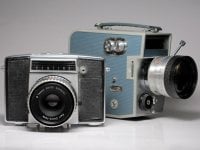
Jason, I think you may well be right, I have found some pictures of a dismantled Pentina on my workbench taken some years ago and to be honest they make little sense to me now! I also remember that the mirror was a non return device. Here's a picture of one alongside a Pentaflex 8 which really was an advanced masterpiece of 8mm movie camera design but way too heavy. The Pentaflex 16 still commands big money...
Coldkennels
Barnack-toting Brit.
To me, the Pentacon Six has an inexplicable siren-like appeal which has probably sent many a photographer onto the rocks. I think it’s the big focal plane shutter. I saw one recently for a good price plus a wide angle lens - I hesitated and did not buy it. But I still think about it.
I acquired one in a job lot at a local auction house many, many years back. It came with both the waist level finder and the unmetered pentaprism, and a full kit of the 50/4 Flektagon (an impressively large lens!), the Zeiss Jena 80/2.8 lens (which jammed and dismantled itself in spectacular fashion), a Zeiss Jena Biometar 120/2.8, and a Meyer-Optik Gorlitz Orestegor 300/4 which I don't think I ever used.
Out of the lot, the Flektagon was the real winner. It's a great lens, but the giant front element stressed me out, and the cap had a tendency to drop off. The real problem was the camera body - everything on it went wrong. First there was issues with film spacing and transport, then the shutter started giving uneven exposures, then the whole shutter jammed up altogether. But when it worked, it was fun to use and produced some decent shots.

Untitled by Tony Gale, on Flickr
I still have it sat on a shelf, and maybe at some point I'll look into repairing it (or, more realistically, having someone repair it for me)... but it is an absolute tank to carry about and use. Hard to justify the extra bulk over simply using a TLR, to be honest.
das
Well-known
I acquired one in a job lot at a local auction house many, many years back. It came with both the waist level finder and the unmetered pentaprism, and a full kit of the 50/4 Flektagon (an impressively large lens!), the Zeiss Jena 80/2.8 lens (which jammed and dismantled itself in spectacular fashion), a Zeiss Jena Biometar 120/2.8, and a Meyer-Optik Gorlitz Orestegor 300/4 which I don't think I ever used.
Out of the lot, the Flektagon was the real winner. It's a great lens, but the giant front element stressed me out, and the cap had a tendency to drop off. The real problem was the camera body - everything on it went wrong. First there was issues with film spacing and transport, then the shutter started giving uneven exposures, then the whole shutter jammed up altogether. But when it worked, it was fun to use and produced some decent shots.
Untitled by Tony Gale, on Flickr
I still have it sat on a shelf, and maybe at some point I'll look into repairing it (or, more realistically, having someone repair it for me)... but it is an absolute tank to carry about and use. Hard to justify the extra bulk over simply using a TLR, to be honest.
Adapting a Kiev 60 TTL prism is night and day from the stock unmetered prism or the WLF. I prefer using the P6 like an SLR, rather than a TLR.
Share:
-
This site uses cookies to help personalise content, tailor your experience and to keep you logged in if you register.
By continuing to use this site, you are consenting to our use of cookies.

